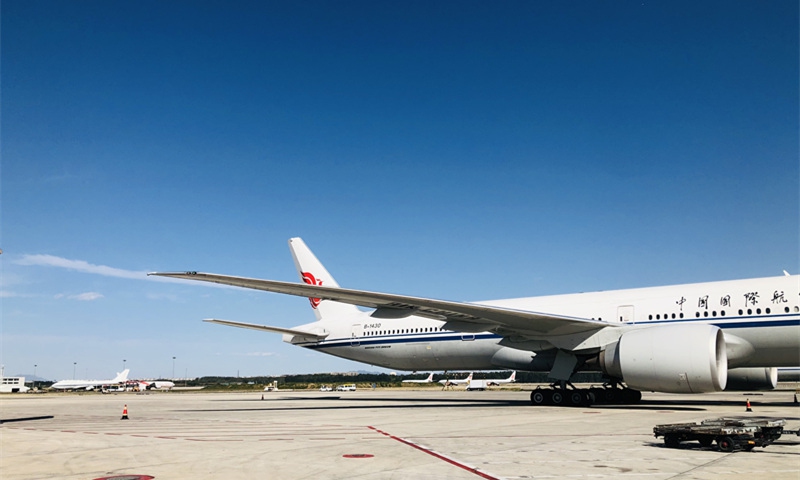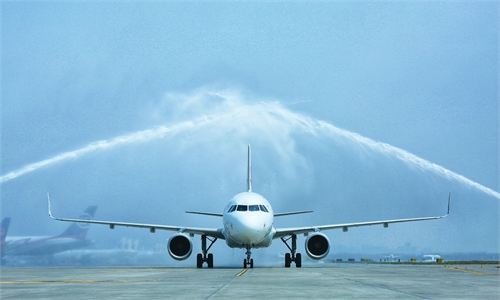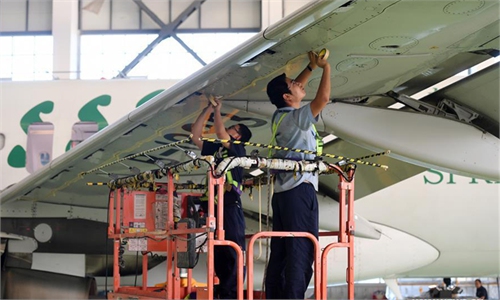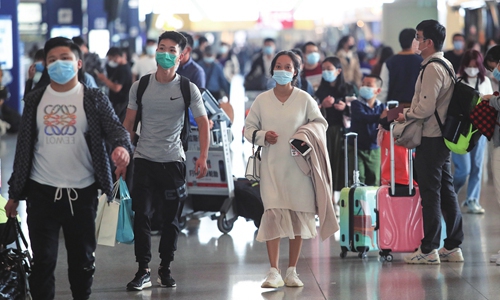SOURCE / INDUSTRIES
Expanding network
Airport development propels China's growing civil aviation sector

An Air China aircraft stands on the tarmac at the Beijing Capital International Airport, China, on October 13, 2020. Photo: Chi Jingyi/GT
China has made major achievements on its way to becoming a global power in air traffic with significant progress in the infrastructure sector.
Continuously improved and upgraded airports and other infrastructures have sustained the high-quality development of China's civil aviation industry over the 13th Five-Year Plan period (2016-2020), according to the Civil Aviation Administration of China (CAAC).
China positioned the civil aviation industry as an important strategic industry of the country's socio-economic development and invested big in the sector.
Top-level design and long-term plans from the related government authorities have been guiding the high-quality development of the industry, said the CAAC.
Significant progress has been made in the construction scale and speed as well as investment volume in airports, key infrastructure of the civil aviation industry.
During the five-year period from 2016 to 2020, an estimated total of up to 460 billion yuan ($69.18 billion) of fixed-asset investment has been injected into civil airport construction, according to the CAAC data.
It represents a 26-percent increase compared with the volume in the 2011-2015 period.
Top-level design, detailed plans and expanded investment helped the industry meet challenges born from insufficient support and service capacity of large and medium airports.
In 2019, China's civil airports handled a passenger throughput of 1.35 billion, air freight of 17.1 million tons and 11.66 million flight movements.
Despite the impact of the epidemic, fixed asset investment in transportation has remained high in the first three quarters of this year.
In the first three quarters, the investment in fixed assets in transportation was 2.51 trillion yuan, a year-on-year increase of 9.8 percent.
This growth rate was achieved under the influence of the epidemic and was hard-won, Wu Chungeng, spokesperson of the Ministry of Transport, said on Wednesday.
He said in terms of civil aviation, passenger traffic on domestic routes has recovered to 98 percent in the third quarter.
Data from information provider VariFlight shows that in September, the number of actual outbound flights at global airports was 1,459,500, a year-on-year decrease of 52.88 percent.
However, the number of flights at China's airports in this period ranks first in the world, and the industry's recovery rate has been fastest, recovering to more than 90 percent of the same level last year. Conversely, the UK flight volume has dropped the most, down 65.36 percent year-on-year.
Reuters reported Wednesday that China's domestic aviation fuel consumption rebounded to near pre-COVID-19 levels in September, thanks to a fast recovery in passenger travel and cargo freight, although demand from international flights remained weak, citing industry sources.
Strategic roles
In accordance with the national civil airport layout plan, the CAAC has been making efforts to increase the country's airport number and extend their service range.
China is now constructing a modern airport system with three world-class airport clusters, 10 international aviation hubs and 29 regional hub airports, together with a number of non-hub airports.
Among the newly constructed airports, the Beijing Daxing International Airport has drawn worldwide attention as a landmark large-scale project and a new engine for national development.
The Daxing airport has emerged as a pivotal air traffic hub for international travel to and from China as the country is poised to become the world's largest civil aviation market around the mid-2020s.
In the past National Day holidays, the airport has handled 741,700 passengers of 5,313 flights. There are 18 carriers such as China Southern Airlines, Eastern Airlines, Air China, China United Airlines and Xiamen Airlines operating 187 domestic routes and 129 destinations across the country.
Increasing the number of airports and enhancing airport capacities also contributes to the national strategies of poverty alleviation and the development of western regions, according to the CAAC.
Over the 2016-2020 period, China constructed 31, moved eight and expanded 34 small hub airports or non-hub airports. Among them, 50 were located in the western, border or poverty-stricken regions.
The number of China's civil transport airports reached 238 by the end of 2019, and the figure is expected to reach 241 by the end of 2020.



